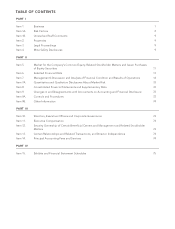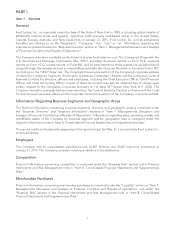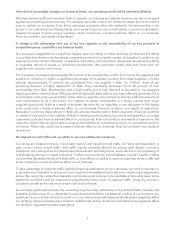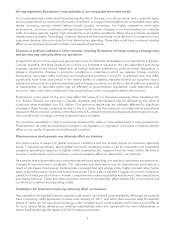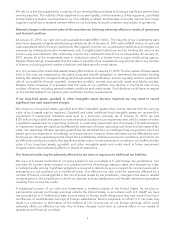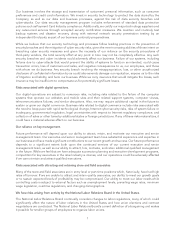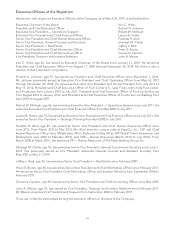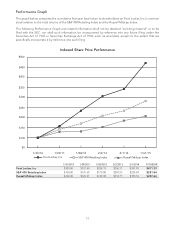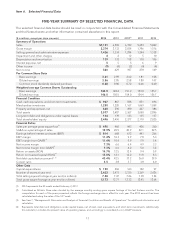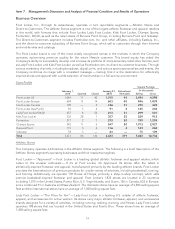Foot Locker 2014 Annual Report Download - page 27
Download and view the complete annual report
Please find page 27 of the 2014 Foot Locker annual report below. You can navigate through the pages in the report by either clicking on the pages listed below, or by using the keyword search tool below to find specific information within the annual report.We may experience fluctuations in and cyclicality of our comparable-store sales results.
Our comparable-store sales have fluctuated significantly in the past, on both an annual and a quarterly basis,
and we expect them to continue to fluctuate in the future. A variety of factors affect our comparable-store sales
results, including, among others, fashion trends, product innovation, the highly competitive retail sales
environment, economic conditions, timing of promotional events, changes in our merchandise mix, calendar
shifts of holiday periods, supply chain disruptions, and weather conditions. Many of our products represent
discretionary purchases. Accordingly, customer demand for these products could decline in a recession or if our
customers develop other priorities for their discretionary spending. These risks could have a material adverse
effect on our business, financial condition, and results of operations.
Economic or political conditions in other countries, including fluctuations in foreign currency exchange rates
and tax rates may adversely affect our operations.
A significant portion of our sales and operating income for 2014 was attributable to our operations in Europe,
Canada, Australia, and New Zealand. As a result, our business is subject to the risks associated with doing
business outside of the United States such as foreign customer preferences, political unrest, disruptions or
delays in shipments, changes in economic conditions in countries in which we operate, foreign currency
fluctuations, real estate costs, and labor and employment practices in non-U.S. jurisdictions that may differ
significantly from those that prevail in the United States. In addition, because we and our suppliers have a
substantial amount of our products manufactured in foreign countries, our ability to obtain sufficient quantities
of merchandise on favorable terms may be affected by governmental regulations, trade restrictions, and
economic, labor, and other conditions in the countries from which our suppliers obtain their product.
Fluctuations in the value of the euro may affect the value of our European earnings when translated into
U.S. dollars. Similarly our earnings in Canada, Australia, and New Zealand may be affected by the value of
currencies when translated into U.S. dollars. Our operating results may be adversely affected by significant
changes in these foreign currencies relative to the U.S. dollar. For the most part, our international subsidiaries
transact in their functional currency, other than in the U.K., whose inventory purchases are denominated in euro,
which could result in foreign currency transaction gains or losses.
Our products are subject to import and excise duties and/or sales or value-added taxes in many jurisdictions.
Fluctuations in tax rates and duties and changes in tax legislation or regulation could have a material adverse
effect on our results of operations and financial condition.
Macroeconomic developments may adversely affect our business.
Our performance is subject to global economic conditions and the related impact on consumer spending
levels. Continued uncertainty about global economic conditions poses a risk as consumers and businesses
postpone spending in response to tighter credit, unemployment, negative financial news, and/or declines in
income or asset values, which could have a material negative effect on demand for our products.
As a retailer that is dependent upon consumer discretionary spending, our results of operations are sensitive to
changes in macroeconomic conditions. Our customers may have less money for discretionary purchases as a
result of job losses, foreclosures, bankruptcies, increased fuel and energy costs, higher interest rates, higher
taxes, reduced access to credit, and lower home prices. There is also a risk that if negative economic conditions
persist for a long period of time or worsen, consumers may make long-lasting reductions to their discretionary
purchasing behavior. These and other economic factors could adversely affect demand for our products and
our financial condition and operating results.
Instability in the financial markets may adversely affect our business.
Any instability in the global financial markets could result in diminished credit availability. Although we currently
have a revolving credit agreement in place until January 27, 2017, and other than amounts used for standby
letters of credit, do not have any borrowings under it, tightening of credit markets could make it more difficult
for us to access funds, refinance our existing indebtedness, enter into agreements for new indebtedness or
obtain funding through the issuance of the Company’s securities.
4








